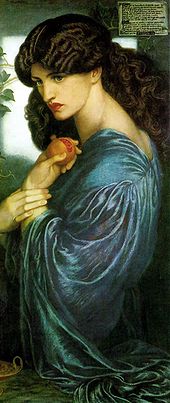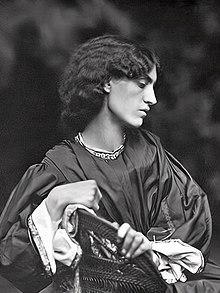Jane Morris
Jane Morris (born Burden ; born October 19, 1839 in Oxford , † January 26, 1914 in Bath ) was the model and muse of the English pre-Raphaelite artist movement and wife of the painter, poet and printer William Morris .
Life
Model for the Pre-Raphaelites


Jane was the eldest daughter of the stable master Robert Burden and his wife Ann Maizey, a washerwoman. In October 1857 she met the painters Dante Gabriel Rossetti and Edward Burne-Jones while visiting the theater . They asked them to sit as models for them. The two artists created murals in the Oxford Union building with motifs from the legend of King Arthur . Jane initially sat mainly for Rossetti, whom she served as a model for his "Queen Guinevere". Jane Burden (later Morris) was the ideal Pre-Raphaelite beauty in many ways . She was tall and slender, with dramatic dark hair and eyes. The painters called her a "stunner" (magnificent woman, class woman). In photographs you can also see a melancholy (seriousness) in their appearance. Morris saw in her the essence of the beautiful heroines of his poems and paintings.
Marriage to William Morris
Burden later sat for William Morris for his painting “La belle Iseult”. During this time, the two fell in love and entered into an engagement. Morris gave her education - music , dance , French , Italian and mathematics - and the manners his circles wanted . Contemporaries later described their behavior as "royal" or "majestic". She became known for her strange beauty and the eccentric dresses she wore and made herself.
On April 26, 1859, William Morris and Jane Burden were married at St Michael's Church, Ship Street, Oxford. The ceremony was performed by Morris' friend Richard Watson Dixon, with Charles Faulkner as best man. No one from Morris's family attended the wedding. Morris gave her the Red House in Bexleyheath for her wedding , which Philipp Webb had designed for the couple and which was ready for occupancy in 1860. Friends contributed to the establishment. Edward Burne-Jones painted three murals. Because Morris didn't like the conventional furniture, he built it himself. The women embellished the house with embroidery. The first designs for tapestries were also made here , because Morris did not like wallpaper at the time.
The marriage had two daughters: Jane ( Jenny ) Alice (1861-1935), who suffered from epilepsy , and May (1862-1938).
After her father's death in the fall of 1865, Jane's sister Elizabeth (called Bessie) also moved into the Red House. She was an excellent embroiderer and helped with embroidery work. One of her most notable embroideries was the comforter for Morris' bed in Kelmscott Manor , which she made with her friend De Morgan. The pattern was based on an antique flower pattern and she signed: "Si je puis Jane Morris" (If I could Jane Morris). May Morris embroidered the flounce with a poem by her father.
Relationship with Dante Gabriel Rossetti
From 1871 to 1874 Morris' friend and fellow painter Dante Gabriel Rossetti lived at Kelmscott Manor , the family's country house. Jane Morris sat as a model for many of his portraits and had a love affair with him for many years. Her husband escaped from this situation to Iceland , where he acquired knowledge of the Icelandic legends that later formed a basis for his novels and poetry. When Jane Morris discovered the extent of Rossetti's chloral addiction in 1876 , she broke off relations with him.
Morris was the model for some of Rossetti's most famous paintings, e.g. B. "Pandora", Venus Astarte (Manchester City Galleries), Proserpine (Tate collection), La pia de Tolomei (Spencer Museum of Art, University of Kansas) and The Day Dream (Victoria & Albert Museum).
During this time she went through phases of "invalidity" and back pain for which the causes were unclear. Her husband accompanied her to a cure in Bad Ems in 1869 .
Artistic and political activity, friendships
Jane Morris often designed the clothes for model sitting for Rossetti's paintings and sewed them herself. She also produced a number of books. These were lavishly decorated and bound in vellum paper (soft, parchment-like paper for book covers), velvet or leather. The texts were generally hand-written English and French verses with ornate initials or other decoration. The bookbinder Thomas James Cobden-Sanderson only learned his craft at Jane's persuasion.
In addition to her contributions to her husband's company, which she ran until his death, she also worked for Morris' Society for the Protection of Ancient Buildings , the Icelandic Famine Aid Committee established in 1882, and later for the Kelmscott Printing Company . However, she did not share her husband's political views and his dedication to socialism . Jane retained an attachment to the Liberal Party , but her sympathies tended towards its radical wing. She was also an ardent supporter of the Irish Home Rule , a view she shared with close friends Rosalind Howard, Countess of Carlisle , and the suffragette Jane Cobden .
Her circle of friends included Georgiana and Edward Burne-Jones, the architect Philip Webb , the poet Algernon Swinburne and the painter Marie Spartali Stillman . In 1883 Morris met the poet and political activist Wilfrid Scawen Blunt (1840-1922) and by 1887 at the latest they were a couple. Jane designed the cover for Blunt's volume of poetry, " In vindulis, " which was published in 1889. His poems were printed by Kelmscott Press , probably on her advocacy .
In the years that followed, Jane Morris became a notable pianist .
Later years

After the death of her husband in 1896, she withdrew more and more from the public. In 1913 - a year before her death - she bought Kelmscott Manor, previously only rented, for her daughters for £ 4,000. She worked closely with Sydney Cockerell in winding up the Kelmscott Printing House.
In 1894 she sat as the queen model for a painting by Evelyn De Morgan "The Hour Glass" (Evelyn De Morgan Foundation, London). She also helped her daughter May edit " The Collected Works of William Morris " by identifying and dating manuscripts. She also provided "introductory" materials, including Morris's reminder, proofreading, correcting mistakes, and offering suggestions for improvement.
Jane Morris died on January 26, 1914 in Bath , where she was cured for a lung disease. She was buried next to her husband in the Kelmscott Cemetery in Oxfordshire .
literature
- John Bryson: Dante Gabriel Rossetti and Jane Morris: Your Correspondence. Clarendon Press, Oxford 1976.
- Jan Marsh: Jane and May Morris: A Biographical Story 1839-1938. Pandora Press, London 1986, ISBN 0-86358-026-2 .
- Debra Mancoff: Jane Morris: The Pre-Raphaelite Model of Beauty. Pomegranate, San Francisco 2000, ISBN 0-7649-1337-9 .
- Wendy Parkins: Jane Morris: the burden of history. Edinburgh University Press, Edinburgh 2013, ISBN 978-0-7486-4127-7 .
Web links
- Astarte Syriaca (Venus Astarte) 1875 Sale by Art Gallery
- Pre-Raphaelite Women (English)
- Album of Portraits of Mrs. William Morris (Jane Burden) Posed by Rossetti, 1865. Edited by Gordon Bottomly. Compiled in 1933
- Jane Morris (née Burden) at the National Portrait Gallery
- Photo of daughter Jane Alice Morris (1861–1935)
- The secret supermodel: Rival to Lizzie Siddal, mistress to Rossetti and wife to William Morris, the fascinating life of Pre-Raphaelite muse Jane Burden revealed - Daily Mail online
- Frank C. Sharp: Jane Morris Burden (1839-1914). In: Oxford Dictionary of National Biography. Oxford University Press, 2004
Individual evidence
- ^ Pre-Raphaelite Murals in Oxford
- ^ Tate Collection
- ^ Dictionary of National Biography, 1901 supplement
- ↑ “Pandora” Sotheby's auction 22 May 2014 - See catalog description
- ↑ Astarte Syriaca - Alternately titled: Venus Astarte
- ^ Proserpine by Rossetti, 1874
- ↑ 'La pia de Tolomei'
- ^ The Day Dream
- ^ Home Rule and Ireland
- ^ Death of Rosalind, Lady Carlisle - THE TIMES, Saturday, Aug 13, 1921.
- ↑ Jane Cobden
- ↑ "The Hour Glass"
| personal data | |
|---|---|
| SURNAME | Morris, Jane |
| ALTERNATIVE NAMES | Morris, Jane Burden; Burden, Jane (maiden name) |
| BRIEF DESCRIPTION | English model and muse of the Pre-Raphaelites |
| DATE OF BIRTH | October 19, 1839 |
| PLACE OF BIRTH | Oxford |
| DATE OF DEATH | January 26, 1914 |
| Place of death | Bath |
